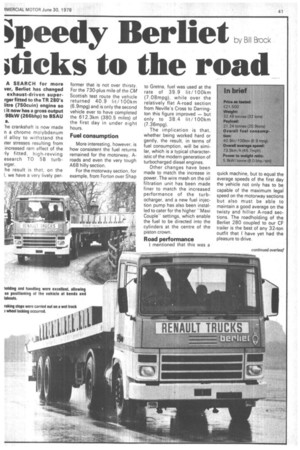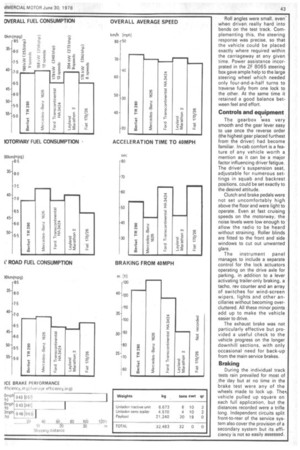ipeedy Bernet ;ticks to the road
Page 47

Page 49

Page 50

If you've noticed an error in this article please click here to report it so we can fix it.
A SEARCH for more ver, Berliet has changed exhaust-driven superrger fitted to the TR 280's litre (750cuin) engine so t it now has a gross output 98kW (266bhp) to BSAU a.
'he crankshaft is now made n a chrome molybdenum ;I alloy to withstand the iter stresses resulting from increased ram effect of the ,ly fitted, high-revving esearch TO 5B turb3 rger.
he result is that, on the I, we have a very lively per former that is not over thirsty. For the 730-plus mile of the CM Scottish test route the vehicle returned 40.9 lit/100km (6.9mpg) and is only the second vehicle ever to have completed the 612.3km (380.5 miles) of the first day in under eight hours.
Fuel consumption
More interesting, however, is how consistent the fuel returns remained for the motorway. Aroads and even the very tough A68 hilly section.
For the motorway section, for example, from Forton over Shap to Gretna, fuel was used at the rate of 39.9 lit/100km (7.08mpg), while over the relatively flat A-road section from Neville's Cross to Darrington this figure improved — but only to 38.4 lit/100km (7.36mpg).
The implication is that, whether being worked hard or gently, the result, in terms of fuel consumption, will be similar, which is a typical characteristic of the modern generation of turbocharged diesel engines.
Other changes have been made to match the increase in power. The wire mesh on the oil filtration unit has been made finer to match the increased performance of the turbocharger, and a new fuel injection pump has also been installed to cater for the higher "Maxi Couple" settings, which enable the fuel to be directed into the cylinders at the centre of the piston crown.
Road performance
I mentioned that this was a
quick machine, but to equal the average speeds of the first day the vehicle not only has to be capable of the maximum legal speed on the motorway sections but also must be able to maintain a good average on the twisty and hillier A-road sections. The roadholding of the Berliet 280 coupled to our CF trailer is the best of any 32-ton outfit that I. have yet had the pleasure to drive. Roll angles were small, even." when driven really hard into bends on the test track. Complementing this, the steering response was precise, so that the vehicle could be placed exactly where required within the carriageway at any given time. Power assistance incorprated in the ZF 8065 steering box gave ample help to the large steering wheel which needed only four-and-a-half turns to traverse fully from one lock to the other. At the same time it retained a good balance between feel and effort.
Controls and equipment The gearbox was very smooth and the gear lever easy to use once the reverse order (the highest gear placed furthest from the driver) had become familiar. In-cab comfort is a feature of any vehicle worth a mention as it can be a major factor influencing driver fatigue. The driver's suspension seat, adjustable for numerous settings in squab and backrest positions, could be set exactly to the desired attitude.
Clutch and brake pedals were not set uncomfortably high above the floor and were light to operate. Even at fast cruising speeds on the motorway, the noise levels were low enough to allow the radio to be heard without straining. Roller blinds are fitted to the front and side windows to cut out unwanted glare.
The instrument panel manages to include a separate control for the lock actuators operating on the drive axle for parking, in addition to a lever activating trailer-only braking, a tacho, rev counter and an array of switches for wind-screen wipers, lights and other ancillaries without becoming overcluttered. All these minor points add up to make the vehicle easier to drive.
The exhaust brake was not particularly effective but provided a useful check to the vehicle progress on the longer downhill sections, with only occasional need for back-up from the main service brakes.
Braking During the individual track tests rain prevailed for most of the day but at no time in the brake test were any of the wheels made to lock up. Thee vehicle pulled up square on each full application, but the distances recorded were a trifle long. Independent circuits split front-to-rear of the service system also cover the provision of a secondary system but its efficiency is not so easily assessed.
Using the park brake instea( and simulating a failure of on half of the system, a peak d celeration of 0.34g wE recorded.
Wet and smooth track conc tions proved to be a distin disadvantage when we came tackle the hill restart tests. La( of traction prohibited the asce of even the gentlest te gradient of 1 in 6 which ak made it impossible to measu the performance of the pa brake at this stage.
Access to the engine is e ceptionally good, even in th age of the tilt cab. The on disadvantage I can foresee this is that it would provide ye little protection against ti weather if the need arose f roadside maintenance.
Summary
Over the three days of tl test I found the TR280 a ye easy vehicle to drive. The engii produced more than adequa power and coupled to an eat to-use gearbox made the vehic as a whole more than a mati for even the stiffest sections our Scottish route. Both ride al roadholding were very goo The one worrying point th arose from the track tests w that of grip, or rather the lack it, on the hill restart test. Even the wet I can't remember a other vehicle being unable climb the 1 in 6 gradient frorr rolling start.
The tyres, Michelin 11-22 Xs, are unlikely to be the caw so we must look further. T drive axle weight is very lo just over 8 tonnes. This rais doubts in my mind about t suitability of the fifth-whE position.
On further inquiry, Berl told me that the trailer woi. need a 1.52m (60in) king position to allow the optimi. loading on the drive axle. C Crane Fruehauf trailer is equ ped with two pin positions, t standard 800mm (31.5) a 1200mm (47in) which were best 330mm (1 3m) too short suit the TR 280. We know frc experience over our test rou that under dry conditions traction problems arose on th( in 7 gradient.
We were not able to det mine whether the vehicle woi be able to cope with a restart such an incline in the wet. T fuel consumption figures w( about average for maximi weight vehicles over this rou and journey times were v( good. A list price of £21,500 the double sleeper cab finish in grey gloss includes a sp wheel but strangely no carriel












































































































